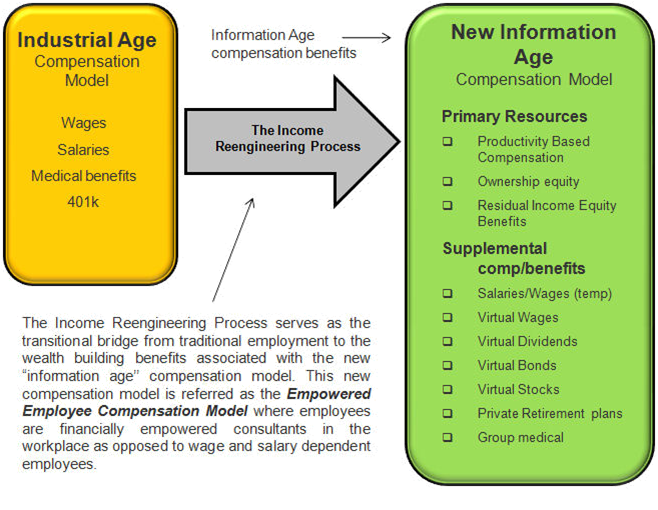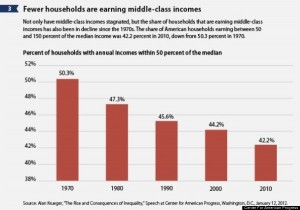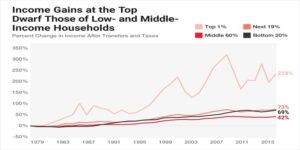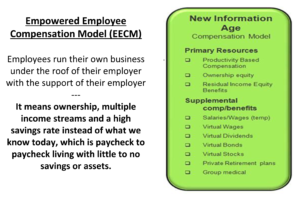First, consider the following:

To understand Income Reengineering, we have to start with the problem we are looking to solve with Income Reengineering principles and processes. Consider this:
- During the industrial revolution, the average worker’s wealth-building capacity increased as workers migrated from farms and small shops to earn a wage in factories. It was a historic transition.
- As we undergo this information revolution, shouldn’t there be a corresponding historic transition that dramatically improves the wealth-building capacity for the masses?? If so, where is it? All we see today is a decreasing middle class and a rising gap between rich and poor.
Middle-class incomes have been decreasing consistently since 1970 ….
…and the gap between rich and poor is rising at alarming levels …..
In addition, increased productivity is the primary benefit of implementing information technology in the workplace. As you can see from the chart below, workers are not benefiting from this increased productivity.
To address these large scale prosperity issues, we launched an economic research initiative to accomplish the following:
To conduct grassroots led economic research into how to apply the internet and other information technology to help the masses increase their workplace income at least 3 times over.
We introduce, teach and present the results of this research under the umbrella of Income Reengineering.
Income Reengineering
Let’s start with a little history regarding the word Reengineering:
- Michael Hammer and James Champy, in their 1993 book Reengineering The Corporation, defined the word Reengineering as the “Fundamental rethinking and radical redesign of business processes to achieve dramatic improvements in critical measures of performance such as cost, service, and speed”;
- This lead to a popular corporate restructuring process called Business Process Reengineering (BPR). BPR started the trend of corporations using information technology to downsize jobs, outsource jobs and eliminate middle management positions all in an effort to cut cost and improve efficiency. This was great for corporations, but horrible for employees and workers and it continues to day.
So, to address this issue and provide solutions for the average worker, we introduce Income Reengineering as a counterbalance initiative to Business process reengineering. Income reengineering is defined as the fundamental rethinking and radical redesign of business processes to achieve dramatic improvements in the income earning and wealth building ability of the average worker while he or she is on the job.
What do we mean by fundamental rethinking and radical redesign? To get into this, let’s start by digging into the phrase economic research phrase noted in the economic research initiative noted above.
Economic Research
Whether we are doing scientific research, economic research or otherwise, all research must start with a hypothesis or a guest as to how to meet our objective. Then we conduct the research to field test, evaluate and validate the hypothesis. If the hypothesis doesn’t work out, we present a new hypothesis and start over.
Here’s our starting hypothesis:
Starting Hypothesis: Given that most people make their living in the workplace, what better way to improve the income and wealth building ability of the masses for the long term than to create a workplace where people effectively run their own business under the roof of their employer with the support of their employer?
Better yet, what better way to solve this workplace productivity issue than to ensure workers own their productivity instead of renting it for an hourly wage or salary?
The workplace compensation model supporting this hypothesis is called the Empowered Employee Compensation Model (EECM). It replaces hourly wages and salaries with 10 new income resources and benefits and will usher in a 3-fold increase in the income producing and wealth building ability of the masses.
As you can see, the central theme associated with the model is employees —employees run their own business under the roof of their employer with the support of their employer. It means ownership, multiple income streams and a high savings rate instead of what we know today, which is paycheck to paycheck living with little to no savings or assets.
In summary, our working hypothesis feeding the economic research is to advocate replacing the old hourly wage/salary-based compensation structure with the new Empowered Employee Compensation Model (EECM) throughout the mainstream economy. This is what we mean by fundamental rethinking and radical redesign relative to achieving dramatic improvements in the income earning and wealth building ability of the masses. We must attack this problem at this fundamental level. We have to fundamental rethink the mainstream workplace as we know it.
How do we advocate? Well, first, we conduct economic research to prove the viability of the hypothesis. In other words, we must teach the model and then put it to the test in the real world to prove its’ viability. Once we prove viability, then we deploy natural economic principles and processes to effectively plant the necessary economic seeds designed to integrate the model into the mainstream workplace over time.
We conduct this economic research in accordance with the four parts of Income Reengineering noted below and supporting operational links
- The Income Reengineering Principle (Part 1)
- Income Reengineering Principle (Part 2)
- Income Reengineering Vision
- The Income Reengineering Process
- General Operations
- Support this Research
- Join IRBDN
Each part play a critical role in stitching together the rudiments of the big picture associated with Income Reengineering. Next, visit Income Reengineering Principle Part 1.




